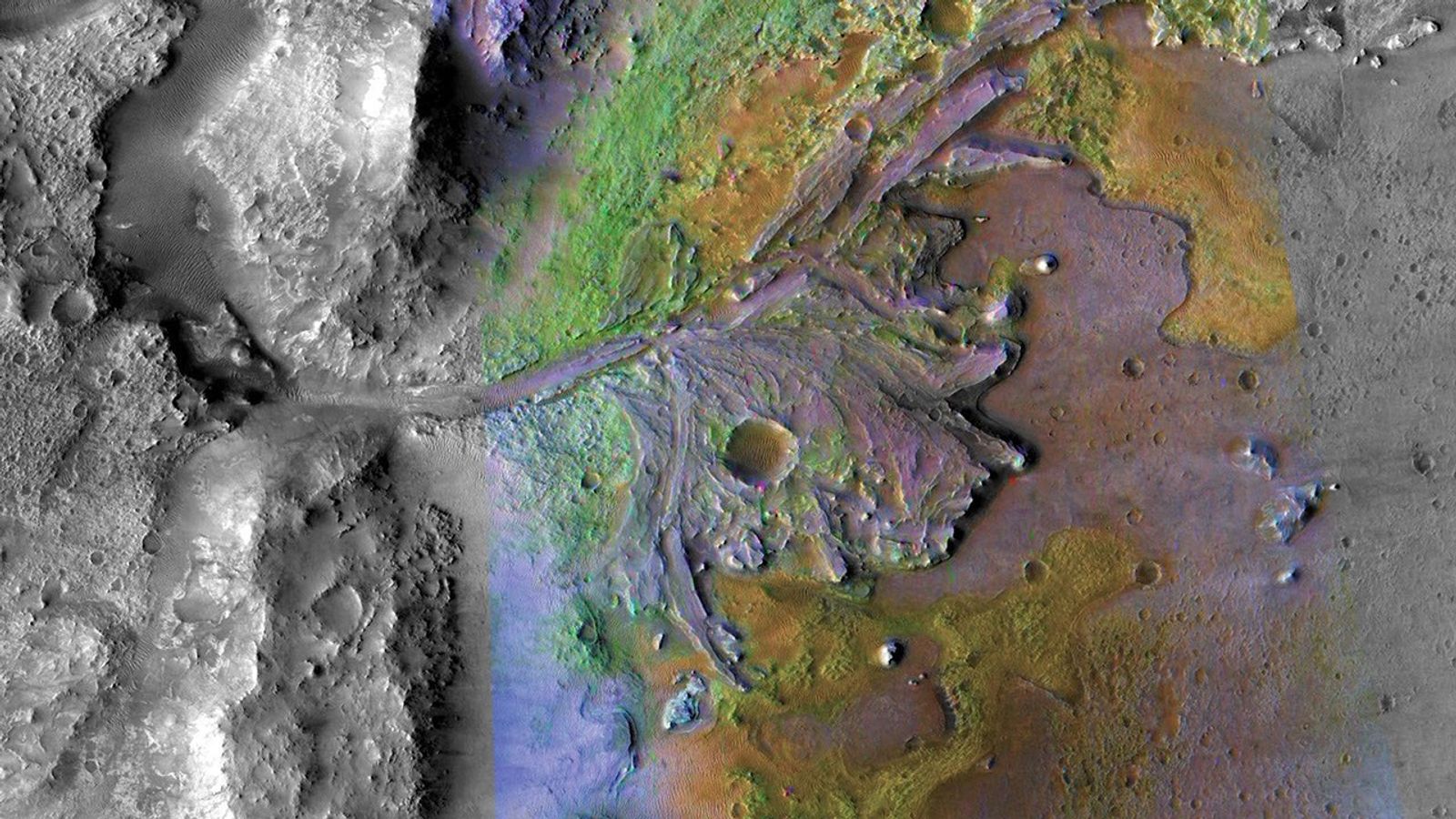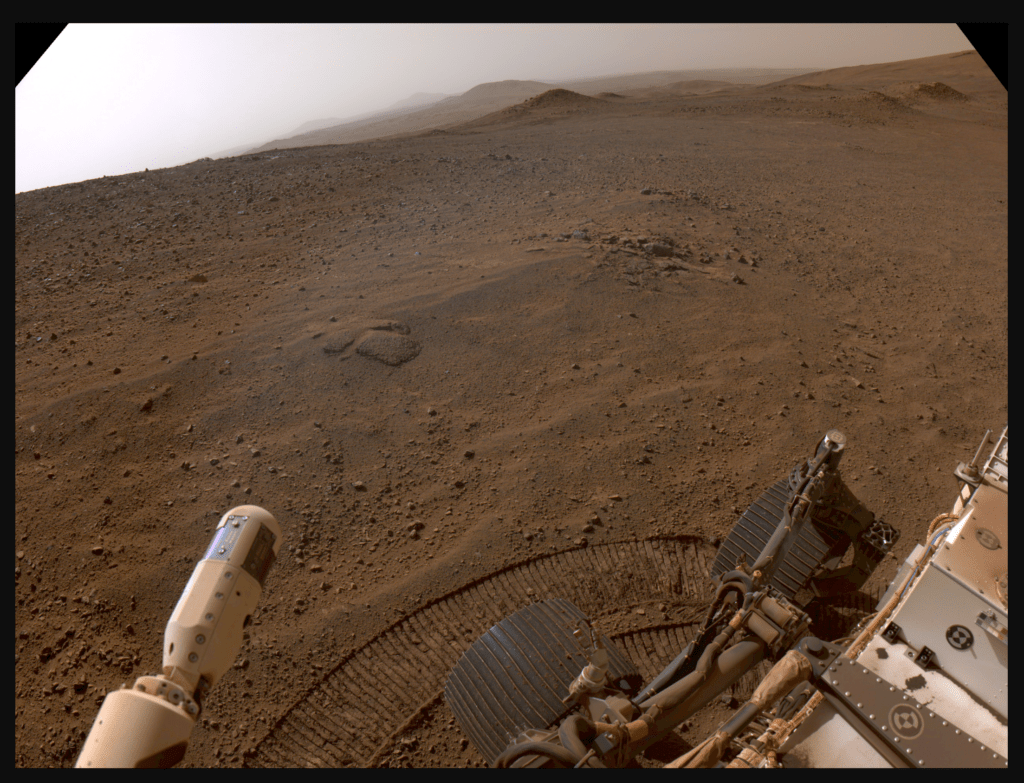The American space agency, NASA, confirmed today during a teleconference the discovery of a possible biosignature in a Mars rock. The finding is related to a Martian rock analyzed by the Perseverance rover. The sample, named “Sapphire Canyon,” was collected in July 2024 in the Neretva Vallis region, an ancient river network that fed Jezero Crater billions of years ago.
Jezero is a crater on Mars, located in the Syrtis Major quadrangle, with a diameter of about 45 km. It is believed to have been flooded with water, and the crater contains a clay-rich alluvial fan (or delta) deposit. The lake in the crater existed while the valley networks were forming on Mars.
In addition to the alluvial fan, the crater shows alluvial deposits in meanders and also inverted channels. From the study of the delta and channels, it was concluded that the lake within the crater likely formed during a period of continuous surface runoff. In 2007, after the discovery of its ancient lake, the crater was named in honor of Jezero, a city in Bosnia and Herzegovina, one of several cities with the same name in the country. In some Slavic languages, the word jezero means “lake.”
In November 2018, it was announced that Jezero had been selected as the landing site for the Perseverance rover as part of NASA’s Mars 2020 mission.

Collected from a rock called “Cheyava Falls” last year, the sample named “Sapphire Canyon” contains potential biosignatures, according to an article published Wednesday in the journal Nature.
A potential biosignature is a substance or structure that may have a biological origin but requires additional data or studies before any conclusions can be drawn regarding the presence or absence of life.
“This discovery by Perseverance, launched during President Trump’s first term, is the closest we have ever come to discovering life on Mars. Identifying a potential biosignature on the Red Planet is a groundbreaking finding that will advance our understanding of Mars,” said NASA Acting Administrator Sean Duffy. “NASA’s commitment to conducting gold-standard science will continue as we pursue our goal of putting Americans on the rocky surface of Mars.”

Perseverance arrived at Cheyava Falls in July 2024 while exploring the “Bright Angel” formation, a set of rock outcrops along the northern and southern edges of Neretva Vallis, an ancient river valley about 400 meters wide, carved by water that flowed long ago into Jezero Crater.
“This discovery is the direct result of NASA’s effort to strategically plan, develop, and execute a mission capable of delivering precisely this kind of science — the identification of a potential biosignature on Mars,” said Nicky Fox, Associate Administrator of NASA’s Science Mission Directorate at headquarters in Washington. “With the publication of this peer-reviewed result, NASA is making these data available to the scientific community for further study, to confirm or refute its potential biological origin.”
The rover’s scientific instruments found that the sedimentary rocks of the formation are composed of clay and silt, which on Earth are excellent preservers of past microbial life. They are also rich in organic carbon, sulfur, oxidized iron (rust), and phosphorus.
“The combination of chemical compounds we found in the Bright Angel formation could have been a rich source of energy for microbial metabolism,” said Joel Hurowitz, a Perseverance scientist at Stony Brook University in New York and lead author of the paper. “But just because we saw all these compelling chemical signatures in the data did not mean we had a potential biosignature. We needed to analyze what these data could actually mean.”

The PIXL and SHERLOC instruments on the Perseverance rover were the first to analyze the rock at Cheyava Falls, a spear-shaped formation. During the investigation, they detected colored spots on the rock, which could have formed from microbial activity using elements in the sediment—such as organic carbon, sulfur, and phosphorus—as an energy source.
High-resolution images revealed a distinct mineral pattern, nicknamed “leopard spots,” containing iron-rich minerals like vivianite and greigite. On Earth, these minerals can form in association with organic matter and microbial life. The combination found in Bright Angel suggests that electron transfer reactions, potentially mediated by microbial life, could have produced energy for growth.

However, these minerals can also form abiotically—without biological involvement—under conditions such as high temperatures, acidity, or interactions with organic compounds. The Bright Angel rocks show no evidence of high temperatures or acidity, and it remains unclear whether the organic compounds present could catalyze the reaction at low temperatures, making the biological hypothesis more plausible but not conclusive.
The discovery is particularly notable because it involves younger sedimentary rocks than previously studied, suggesting that Mars may have been habitable for longer periods or more recently than previously thought. The research was peer-reviewed, an essential step for validating such significant findings.
Scientists use tools like the CoLD scale and Standards of Evidence to assess the reliability of data related to extraterrestrial life, helping determine whether observed signals can truly indicate the presence of life beyond Earth.










